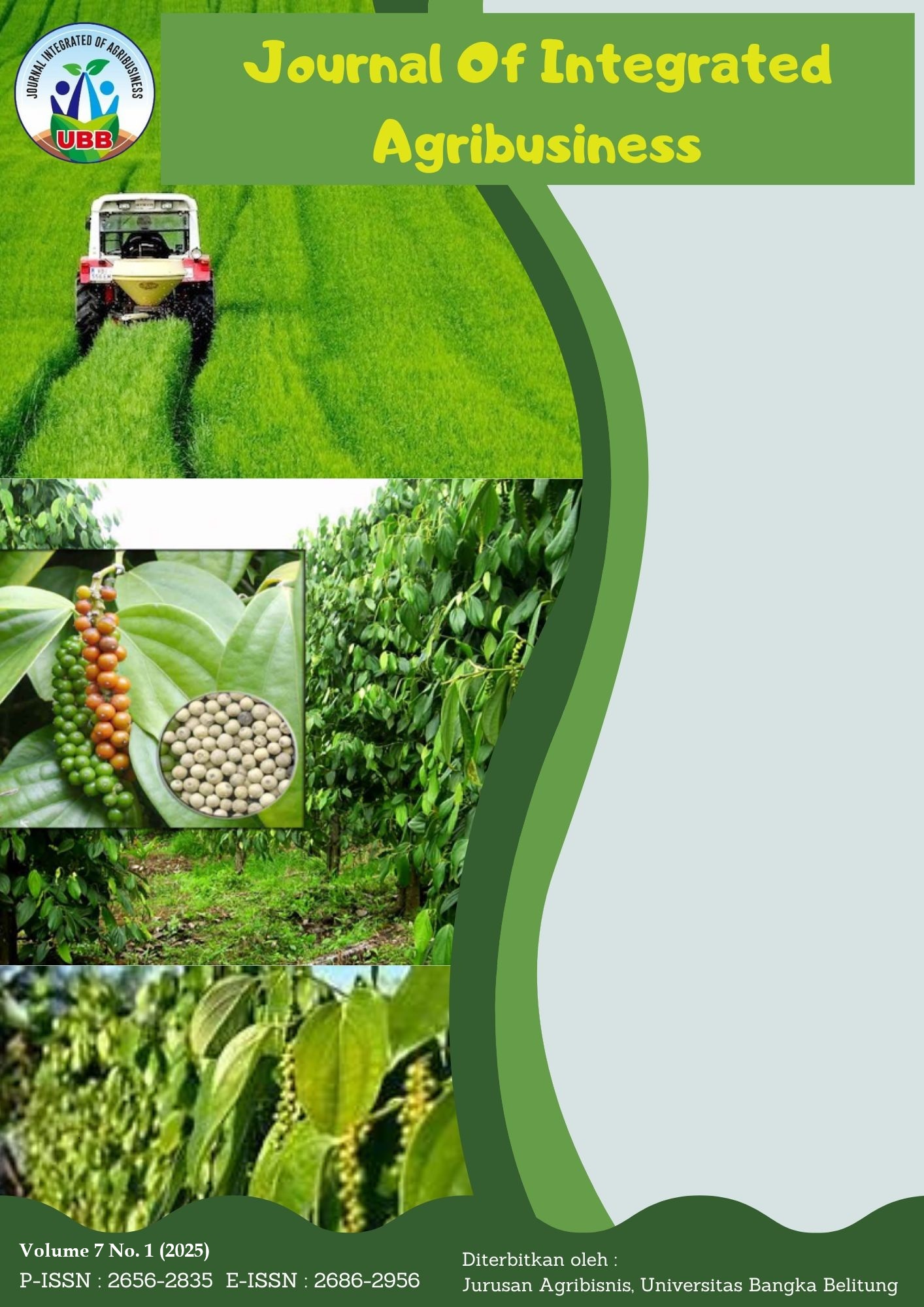Sales Forecast for PT XYZ’s Sterilized Milk Products in the Jakarta Market for 2025 Using the ARIMA (Autoregressive Integrated Moving Average) Model
Peramalan Penjualan Produk Susu Steril PT XYZ di Pasar Jakarta Tahun 2025 Menggunakan Model ARIMA (Autoregressive Integrated Moving Average)
DOI:
https://doi.org/10.33019/jia.v7i1.6347Keywords:
ARIMA, FMCG, Sales Forecast, Sterilized MilkAbstract
This study examines the sales forecast for PT XYZ’s sterilized milk products, recognizing the critical importance of accurate forecasting in the dynamic and competitive fast-moving consumer goods (FMCG) sector. Reliable forecasts are essential for distributors to optimize demand planning and inventory control. The Autoregressive Integrated Moving Average (ARIMA) model was applied to historical monthly sales data from 16 distributors in the Jakarta market covering the 2022–2024 period. The ARIMA procedure included data collection and visualization, stationarity testing (ADF, ACF, PACF), differencing, model identification, parameter estimation, and optimal model selection. The results reveal monthly sales fluctuations with a clear downward trend toward the end of the observation period, with the ARIMA (1,0,1) model emerging as the best fit. Forecasts for 2025 indicate a continued decline in sales value, underscoring the need for stronger collaboration between PT XYZ and its distributors in promotional planning and inventory management to adapt to market shifts and capitalize on emerging opportunities.
Downloads
References
B, R., Chirag, C., & Pai B, G. (2024). Use of predictive analysis, forecasting the trends in the FMCG. SDM Institute for Management Development. https://www.sdmimd.ac.in/marketingconference2024/papers/IMC2479.pdf
Basson, L. M., Kilbourn, P. J., & Walters, J. (2019). Forecast accuracy in demand planning: A fast-moving consumer goods case study. Journal of Transport and Supply Chain Management, 13. https://doi.org/10.4102/jtscm.v13i0.427
Fattah, J., Ezzine, L., Aman, Z., El Moussami, H., & Lachhab, A. (2018). Forecasting of demand using ARIMA model. International Journal of Engineering Business Management, 10, 1847979018808673. https://doi.org/10.1177/1847979018808673
Heizer, J., Render, B., & Munson, C. (2017). Operations management: Sustainability and supply chain (12th ed.). Pearson Education.
Henchion, M., Moloney, A. P., Hyland, J., Zimmermann, J., & McCarthy, S. (2021). Review: Trends for meat, milk and egg consumption for the next decades and the role played by livestock systems in the global production of proteins. Animal, 15, 100287. https://doi.org/10.1016/j.animal.2021.100287
Juliamida, I. S., Haludin, G., Minarso, M. F., Natalia, I., Niser, A., & Iskandar, H. (2024). Analisis penerapan konsep PDCA pada PT Mayora Indah Tbk dalam meningkatkan penjualan dan daya saing di industri FMCG, 4(3).
Khoiri, H. A. (2023). Analisis deret waktu univariat. UNIPMA Press. https://eprint.unipma.ac.id/323/1/1.%20Bu%20Halwa%2015%20Eks%2C%20B5.pdf
Ma, L., Hu, C., Lin, R., & Han, Y. (2018). ARIMA model forecast based on EViews software. IOP Conference Series: Earth and Environmental Science, 208, 012017. https://doi.org/10.1088/1755-1315/208/1/012017
Mahadira, F., & Purwanegara, M. S. (2014). A study of brand consumption and consumer satisfaction towards fast-moving consumer goods. Journal of Business and Management, 3(1), 61–75.
Meher, B. K., Hawaldar, I. T., Spulbar, C. M., & Birau, F. R. (2021). Forecasting stock market prices using mixed ARIMA model: A case study of Indian pharmaceutical companies. SSRN Electronic Journal. https://doi.org/10.2139/ssrn.3771334
Nuryani, F. T., Nurkesuma, N., & Hadibrata, B. (2022). Korelasi keputusan pembelian: Kualitas produk, persepsi harga dan promosi (literature review manajemen pemasaran). Jurnal Ekonomi Manajemen Sistem Informasi, 3(4). https://d1wqtxts1xzle7.cloudfront.net/108066244/612-libre.pdf
Perera, H. N., & Fahimnia, B. (2024). Multi-period ordering decisions in the presence of retail promotions. European Journal of Operational Research, 319(3), 763–776. https://doi.org/10.1016/j.ejor.2024.07.009
Prasetyo, K., Putri, D. D., Kartika Eka Wijayanti, I., & Zulkifli, L. (2023). Forecasting of red chilli prices in Banyumas Regency: The ARIMA approach. E3S Web of Conferences, 444, 02017. https://doi.org/10.1051/e3sconf/202344402017
Pusat Data dan Sistem Informasi Pertanian. (2022). Statistik pertanian. Pusat Data dan Sistem Informasi Pertanian, Kementerian Pertanian Republik Indonesia. https://satudata.pertanian.go.id/assets/docs/publikasi/BUKU_STATISTIK_PERTANIAN_2022_compressed.pdf
Regina, T., & Jodiawan, P. (2021). Proposed improvement of forecasting using time series forecasting of fast-moving consumer goods. JIEMS (Journal of Industrial Engineering and Management Systems), 14(1). https://doi.org/10.30813/jiems.v14i1.2418
Santos, V., Sampaio, M., & Alliprandini, D. H. (2020). The impact of product variety on fill rate, inventory and sales performance in the consumer goods industry. Journal of Manufacturing Technology Management, 31(7), 1481–1505. https://doi.org/10.1108/JMTM-06-2019-0213
Selvakumar, S., Renugadevi, G., Vinishah, N., & Yashwanth, R. (2024). Sales forecasting based on time series analysis. 2024 International Conference on Science Technology Engineering and Management (ICSTEM), 1–7. https://doi.org/10.1109/ICSTEM61137.2024.10560659
Suwignjo, P., Panjaitan, L., Baihaqy, A. R., & Rusdiansyah, A. (2023). Predictive analytics to improve inventory performance: A case study of an FMCG company. Operations and Supply Chain Management: An International Journal, 293–310. https://doi.org/10.31387/oscm0530390
Tahirov, N. (2024). Service level anchoring in demand forecasting: The moderating impact of retail promotions and product perishability [Dataset]. Zenodo. https://doi.org/10.5281/ZENODO.13942993
Tajrin, T., Hendra, H., & Gurning, J. F. (2024). Analisis performansi metode autoregressive integrated moving average (ARIMA) dalam pengendalian persediaan susu. Jurnal Teknik Informasi dan Komputer (Tekinkom), 7(1), 481. https://doi.org/10.37600/tekinkom.v7i1.1222
Tampubolon, A. L., Dani, D., Andini, Y., Lala, L., Mutiara, M., Sinaga, C., Silalahi, R., & Ompusunggu, D. P. (2024). Aplikasi dan analisis statistik menggunakan Stata untuk TSLS, Probit, Logit, dan Tobit. Jurnal Ekonomi dan Pembangunan Indonesia, 2(1), 69–72. https://doi.org/10.61132/jepi.v2i1.281
Trihatmoko, R. A., & Mulyani, R. (2018). Distribution strategy for new product marketing success: Fast moving consumer goods (FMCG) business. Management and Human Resource Research Journal, 7(12). http://repo.unsa.ac.id/216/1/Distribution%20Strategy%20For%20New%20Product%20Marketing%20Success.pdf
Trihatmoko, R. A., Mulyani, R., & Lukviarman, N. (2018). Product placement strategy in the business market competition: Studies of fast moving consumer goods. Business and Management Horizons, 6(1), 150. https://doi.org/10.5296/bmh.v6i1.13239
Wulandari, S., & Bowo, P. A. (2019). Economic education analysis journal. Economic Education Analysis Journal. https://doi.org/10.15294/eeaj.v13i2.35717
Downloads
Published
Issue
Section
License
Copyright (c) 2025 Akbar Bimo Prastio, Imam Widhiono, Sri Lestari, Budi Dharmawan

This work is licensed under a Creative Commons Attribution-NonCommercial 4.0 International License.










